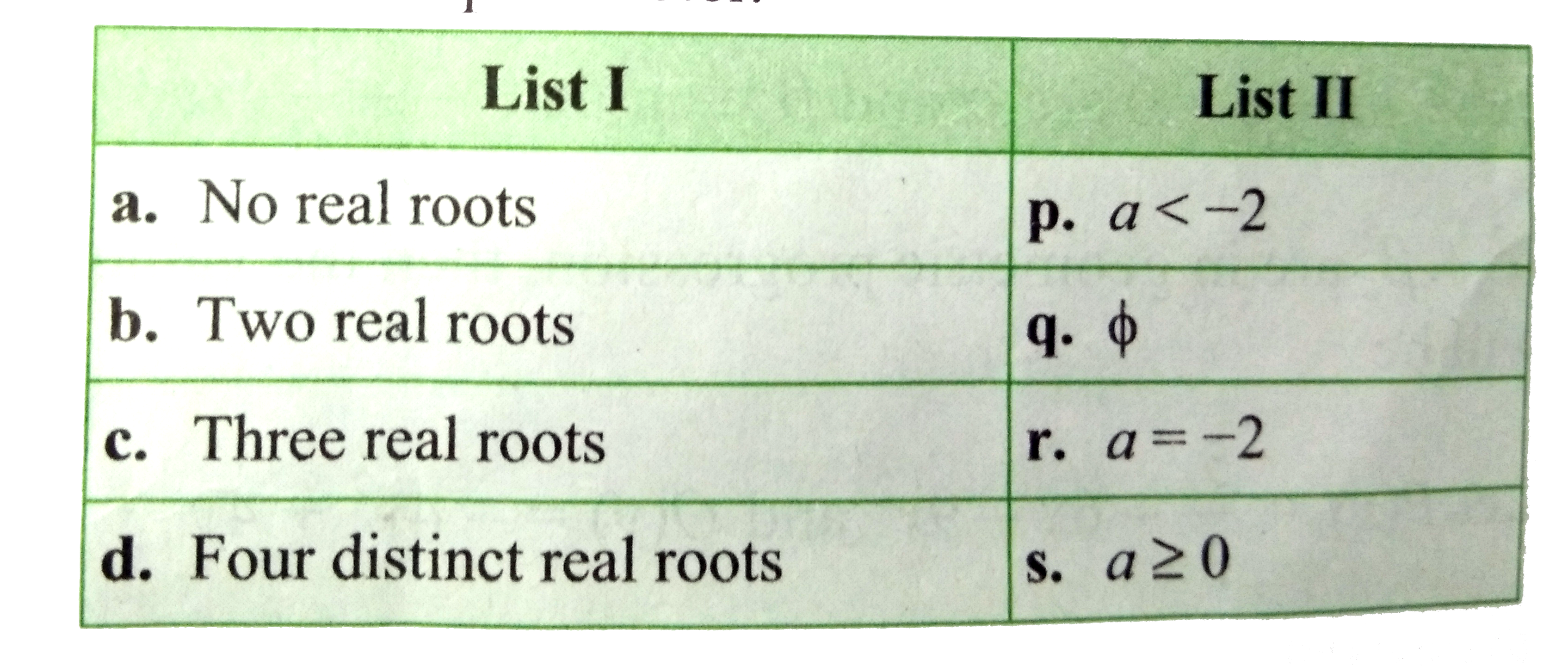Let P(x)=x4+ax3+bx2+cx+d be a polynomial such that P(1)=1,P(2)=8,P(3)=27,P(4)=64 then the value of 152−P(5) is____________.Solution in Bengali
The correct Answer is:149
Cleraly, P(x)−x3=0 has roots 1, 2, 3, 4.
∴P(x)−x3=(x−1)(x−2)(x−3)(x−4)
⇒P(x)=(x−1)(x−2)(x−3)(x−4)+x3
Hence, P(5)=1×2×3×4+125=149
Topper's Solved these Questions
- BOOK - CENGAGE PUBLICATIONCHAPTER - THEORY OF EQUATIONSEXERCISE - Archives JEE MAIN (single correct Answer Type )7videos
THEORY OF EQUATIONS
- BOOK - CENGAGE PUBLICATIONCHAPTER - THEORY OF EQUATIONSEXERCISE - JEE ADVANCED (Single Correct Type )5videos
THEORY OF EQUATIONS
- BOOK - CENGAGE PUBLICATIONCHAPTER - THEORY OF EQUATIONSEXERCISE - MATRIX MATCH TYPE6videos
THEORY OF EQUATIONS
- BOOK - CENGAGE PUBLICATIONCHAPTER - STRAIGHT LINESEXERCISE - ARCHIVES (NUMERICAL VALUE TYPE)1videos
STRAIGHT LINES
- BOOK - CENGAGE PUBLICATIONCHAPTER - THREE DIMENSIONAL GEOMETRYEXERCISE - All Questions291videos
THREE DIMENSIONAL GEOMETRY
Similar Questions
If the roots of the equation bx2+cx+a=0 be imaginary, then for all real values of x, the expression 3b2x2+6bcx+2c2 is (1) greater than 4ab (2) less than 4ab (3) greater than −4ab (4) less than 4ab
04:38View SolutionQ. Let p and q real number such that p≠0,p2≠q and p2≠−q. if α and β are non-zero complex number satisfying α+β=−p and α3+β3=q, then a quadratic equation having αβ and βα as its roots is
02:14View SolutionMatch the following for the equation x2+a|x|+1=0 where, a is a parameter.
 07:35View Solution
07:35View SolutionFor a point P in the plane, let d1(P)andd2(P) be the distances of the point P from the lines x−y=0andx+y=0 respectively. The area of the region R consisting of all points P lying in the first quadrant of the plane and satisfying 2≤d1(P)+d2(P)≤4, is
01:34View SolutionFind the angle between the line whose direction cosines are given by l+m+n=0andl2+m2−n2=0.
01:43View SolutionLet P(x) be a cubic polynomial such that coefficient of x^(3) is 1;p(1)=1,p(2)=2,p(3)=3 then the value of p(4) is :
02:11View SolutionLet P(x)=x4+ax3+bx2+cx+d be a polynomial such that P(1)=1,P(2)=8,+P(3)=27,P(4)=64 then the value of 152−P(5) is____________.
03:17View SolutionA cubic polynomial p(x) is such that p(1)=1,p(2)=2,p(3)=3 and p(4)=5 then the value of p(6) is
01:59View SolutionIf x+1x=p , the value of x3+1x3 is p3+1p3 (b) p3−3p (c) p3 (d) p3+3p
03:14View SolutionLet P(x)=x^(4)+ax^(3)+bx^(2)+cx+d be a polynomial such that P(1)=1,P(2)=8,P(3)=27,P(4)=64 then find P(10)
View SolutionLet P(x) be a polynomial of degree 11 such that P(x)=1x+1 for x=0,1,2,3,….11. The value of P(12) is.
02:15View SolutionLet p(x)=x2−4x+3. Find the value of p(1) and obtain zeroes of the polynomial p(x).
04:18View SolutionLet P(x)=x4+ax3+bx2+cx+d be a polynomial such that P(1)=1,P(2)=8,P(3)=27,P(4)=64 then value of P(5)=K then the number of digits of K=
04:22View SolutionLet P(x)=P(0)+P(1)x+P(2)x2 be a polynomial such that P(−1)=1 ,then P(3) is :
05:26View SolutionLet a,b,c, d be the roots of x4−x3−x2−1=0. Also consider P(x)=x6−x5−x3−x2−x, then the value of p(a)+p(b)+p(c)+p(d) is equal to :
View SolutionLet P(x)=x4+ax3+bx2+cx+d be a polynomial such that P(1)=1,P(2)=8,P(3)=27,P(4)=64 then the value of 152−P(5) is____________.
03:09View Solution

